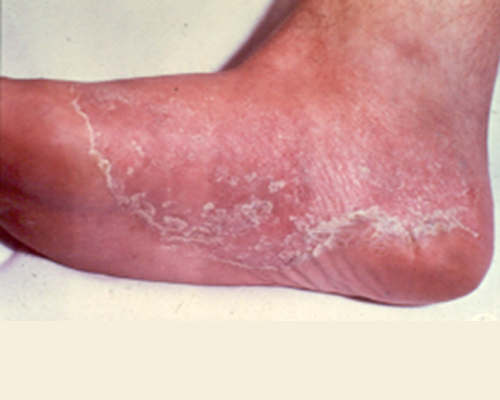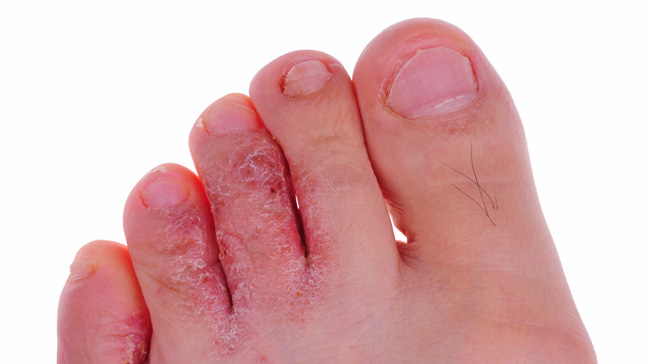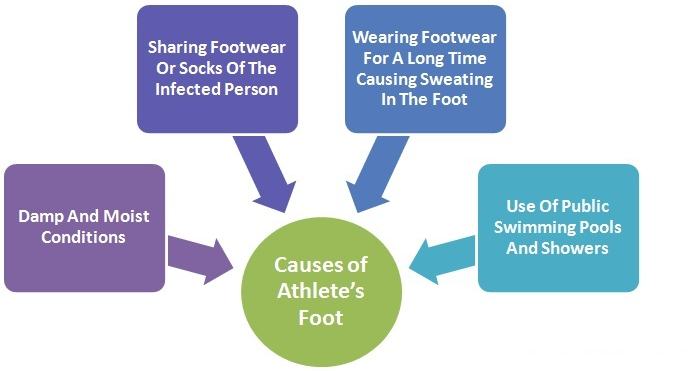Athlete’s foot is one of those topics that everyone seems to know a little about but not enough to really understand. If your level of knowledge is “scaly, itchy rash on the feet = go to the pharmacy,” you need to empower yourself with some Straight, No Chaser answers to these frequently asked questions about athlete’s foot.
What puts me at risk for athlete’s foot?
- If you frequently wear socks that are or become moist
- If you frequently wear tight shoes
- If you have diabetes, lupus, chronically take steroids or have another illness that lowers your immunity
- If you’re male
- If you’re with someone in the midst of a fungal infection and share bed sheets, carpeting, rugs, or shoes with them
- If you’re barefoot while exposed in public areas such as showers, saunas or swimming pools
What causes athlete’s foot?
Tinea pedis (aka athlete’s foot) is a fungal infection. Tinea is the same family of fungi that produces the conditions known as jock itch and ringworm.
What are the symptoms of athlete’s foot?

Look for a dry, scaly rash that most often is noticed between your toes. It produces itching and burning. It can progress to include blisters and/or ulcers.
Is athlete’s foot contagious? How is it spread?
Athlete’s foot is very contagious and is usually spread by floors, clothes, towels, bed sheets or rugs. Your hands can play a role in spreading it as well. Picking at the lesions with your hands can infect them and further spread the fungus to your groin or your nails.
What should I do to prevent athlete’s foot?
Try these simple tips.
- Wear clean socks that you change regularly or anytime they become wet.
- Keep your feet dry. Regarding prevention, barefoot and dry is infinitely better than covering your feet with sweaty socks.
- Avoid vinyl or rubber shoes, as these retard ventilation and promote fungal growth.
- Don’t wear the same shoes every day. They need to dry out.
- Don’t share shoes.
- Wear shower shoes or waterproof sandals in public places.
When should I see a doctor? How can athlete’s foot be treated?

Here are some principles to care for and treat athlete’s foot.
- If you have diabetes or a lowered immunity, see a physician immediately upon onset of athlete’s foot.
- If you have athlete’s foot and develop pronounced or prolonged redness, swelling, warmth, fever or drainage, you should see a physician as soon as possible.
- If you have normal immunity, it is reasonable to try an over-the-counter medication; these come in lotions, ointments, powders or sprays.
- If you have athlete’s foot resistant to self-help efforts after a few weeks, you should see a physician.
Feel free to ask your SMA expert consultant any questions you may have on this topic.
Order your copy of Dr. Sterling’s new book Behind The Curtain: A Peek at Life from within the ER at jeffreysterlingbooks.com, iTunes, Amazon, Barnes and Nobles and wherever books are sold.
Thanks for liking and following Straight, No Chaser! This public service provides a sample of what http://www.SterlingMedicalAdvice.com (SMA) and 844-SMA-TALK offers. Please share our page with your friends on WordPress, like us on Facebook @ SterlingMedicalAdvice.com and follow us on Twitter at @asksterlingmd.
Copyright © 2016 · Sterling Initiatives, LLC · Powered by WordPress




